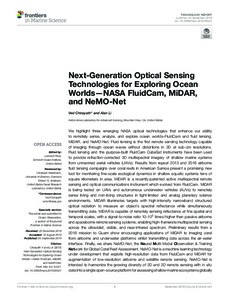| dc.contributor.author | Chirayath, Ved | |
| dc.contributor.author | Li, Alan | |
| dc.date.accessioned | 2020-06-09T23:52:46Z | |
| dc.date.available | 2020-06-09T23:52:46Z | |
| dc.date.issued | 2019 | |
| dc.identifier.citation | Chirayath, V. and Li, A. (2019)
Next-Generation Optical Sensing
Technologies for Exploring Ocean
Worlds—NASA FluidCam, MiDAR,
and NeMO-Net.
Frontiers in Marine Science, 6:521, 24pp. DOI: 10.3389/fmars.2019.00521 | en_US |
| dc.identifier.uri | http://hdl.handle.net/11329/1350 | |
| dc.identifier.uri | http://dx.doi.org/10.25607/OBP-856 | |
| dc.description.abstract | We highlight three emerging NASA optical technologies that enhance our ability
to remotely sense, analyze, and explore ocean worlds–FluidCam and fluid lensing,
MiDAR, and NeMO-Net. Fluid lensing is the first remote sensing technology capable
of imaging through ocean waves without distortions in 3D at sub-cm resolutions.
Fluid lensing and the purpose-built FluidCam CubeSat instruments have been used
to provide refraction-corrected 3D multispectral imagery of shallow marine systems
from unmanned aerial vehicles (UAVs). Results from repeat 2013 and 2016 airborne
fluid lensing campaigns over coral reefs in American Samoa present a promising new
tool for monitoring fine-scale ecological dynamics in shallow aquatic systems tens of
square kilometers in area. MiDAR is a recently-patented active multispectral remote
sensing and optical communications instrument which evolved from FluidCam. MiDAR
is being tested on UAVs and autonomous underwater vehicles (AUVs) to remotely
sense living and non-living structures in light-limited and analog planetary science
environments. MiDAR illuminates targets with high-intensity narrowband structured
optical radiation to measure an object’s spectral reflectance while simultaneously
transmitting data. MiDAR is capable of remotely sensing reflectance at fine spatial and
temporal scales, with a signal-to-noise ratio 10-103 times higher than passive airborne
and spaceborne remote sensing systems, enabling high-framerate multispectral sensing
across the ultraviolet, visible, and near-infrared spectrum. Preliminary results from a
2018 mission to Guam show encouraging applications of MiDAR to imaging coral
from airborne and underwater platforms whilst transmitting data across the air-water
interface. Finally, we share NeMO-Net, the Neural Multi-Modal Observation & Training
Network for Global Coral Reef Assessment. NeMO-Net is a machine learning technology
under development that exploits high-resolution data from FluidCam and MiDAR for
augmentation of low-resolution airborne and satellite remote sensing. NeMO-Net is
intended to harmonize the growing diversity of 2D and 3D remote sensing with in situ
data into a single open-source platformfor assessing shallowmarine ecosystems globally using active learning for citizen-science based training. Preliminary results from four-class
coral classification have an accuracy of 94.4%. Together, these maturing technologies
present promising scalable, practical, and cost-efficient innovations that address current
observational and technological challenges in optical sensing of marine systems. | en_US |
| dc.language.iso | en | en_US |
| dc.rights | Attribution 4.0 International | * |
| dc.rights.uri | http://creativecommons.org/licenses/by/4.0/ | * |
| dc.subject.other | Remote sensing | en_US |
| dc.subject.other | Coral reefs | en_US |
| dc.subject.other | UAVs | en_US |
| dc.subject.other | Fluid lensing | en_US |
| dc.subject.other | MiDAR | en_US |
| dc.subject.other | Machine learning | en_US |
| dc.subject.other | NeMO-Net | en_US |
| dc.title | Next-Generation Optical Sensing Technologies for Exploring Ocean Worlds—NASA FluidCam, MiDAR, and NeMO-Net. | en_US |
| dc.type | Journal Contribution | en_US |
| dc.description.refereed | Refereed | en_US |
| dc.format.pagerange | 24pp. | en_US |
| dc.identifier.doi | 10.3389/fmars.2019.00521 | |
| dc.subject.parameterDiscipline | Parameter Discipline::Cross-discipline | en_US |
| dc.subject.dmProcesses | Data Management Practices::Data acquisition | en_US |
| dc.bibliographicCitation.title | Frontiers in Marine Science | en_US |
| dc.bibliographicCitation.volume | 6 | en_US |
| dc.bibliographicCitation.issue | Article 521 | en_US |
| dc.description.sdg | 14.A | en_US |
| dc.description.maturitylevel | TRL 8 Actual system completed and "mission qualified" through test and demonstration in an operational environment (ground or space) | en_US |
| dc.description.bptype | Manual (incl. handbook, guide, cookbook etc) | en_US |
| obps.contact.contactname | Ved Chirayath | |
| obps.contact.contactemail | ved.c@nasa.gov | |
| obps.resourceurl.publisher | https://www.frontiersin.org/articles/10.3389/fmars.2019.00521/full | en_US |
 Repository of community practices in Ocean Research, Applications and Data/Information Management
Repository of community practices in Ocean Research, Applications and Data/Information Management

